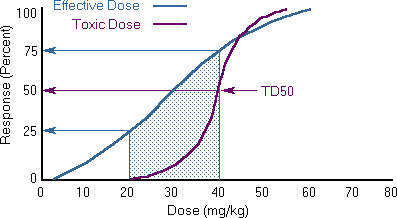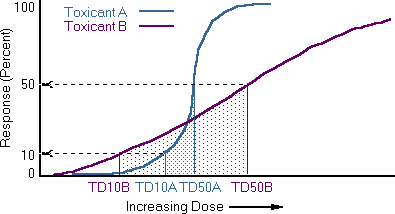|
 |
 |
 |
 |
|
|
|






Therapeutic Index

The Therapeutic Index (TI) is used to compare the therapeutically effective dose to the toxic dose. The TI is a statement of relative safety of a drug. It is the ratio of the dose producing toxicity to the dose needed to produce the desired therapeutic response. The common method used to derive the TI is to use the 50% dose-response points. For example, if the LD50 is 200 and the ED50 is 20 mg, the TI would be 10 (200/20). A clinician would consider a drug safer if it had a TI of 10 than if it had a TI of 3.
The use of the ED50 and LD50 doses to derive the TI may be misleading as to safety, depending on the slope of the dose-response curves for therapeutic and lethal effects. To overcome this deficiency, toxicologists often use another term to denote the safety of a drug - the Margin of Safety (MOS).
The MOS is usually calculated as the ratio of the dose that is just within the lethal range (LD01) to the dose that is 99% effective (ED99). The MOS = LD01/ED99. A physician must use caution in prescribing a drug in which the MOS is less than 1.
Due to differences in slopes and threshold doses, low doses may be effective without producing toxicity. Although more patients may benefit from higher doses, this is offset by the probability that toxicity or death will occur. The relationship between the Effective Dose response and the Toxic Dose response is illustrated above.
Knowledge of the slope is important in comparing the toxicity of various substances. For some toxicants a small increase in dose causes a large increase in response (toxicant A, steep slope). For other toxicants a much larger increase in dose is required to cause the same increase in response (toxicant B, shallow slope).

  
|
|
|
|


